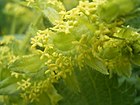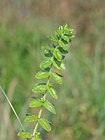Note: This is a project under development. The articles on this wiki are just being initiated and broadly incomplete. You can Help creating new pages.
Difference between revisions of "Cruciata laevipes - Smooth bedstraw"
m (Prabhakar moved page Cruciata laevipes to Smooth bedstraw (Cruciata laevipes)) |
|||
| (9 intermediate revisions by 2 users not shown) | |||
| Line 1: | Line 1: | ||
[[File:Cruciata laevipes closeup.jpg|thumb|right|''Crosswort'', ''Cruciata laevipes'']] | [[File:Cruciata laevipes closeup.jpg|thumb|right|''Crosswort'', ''Cruciata laevipes'']] | ||
| − | |||
| − | + | '''Crosswort''' is a species of Flowering plant in the Rubiaceae family. | |
| − | |||
| − | |||
| − | == Uses == | + | ==Uses== |
| + | {{Uses|Cancer}}, {{Uses|Epilepsy}}, {{Uses|Hysteria}}, {{Uses|Spasms}}, {{Uses|Tumors}}, {{Uses|Loss of appetite}}, {{Uses|Lung ailments}}, {{Uses|Chest ailments}}, {{Uses|Sore throats}} | ||
| − | + | ==Parts Used== | |
| − | + | {{Parts Used|Leaves}}. | |
| − | |||
| − | == | + | ==Chemical Composition== |
| + | Combination of mechanical and herbicide treatments may be most effective. This plant has a high tolerance to some herbicides<ref name="chemical composition"/> | ||
| − | + | ==Common names== | |
| + | {{Common names|kn=|ml=|sa=|ta=|te=|hi=|en=Agrimony}} | ||
| − | == | + | ==Properties== |
| + | Reference: Dravya - Substance, Rasa - Taste, Guna - Qualities, Veerya - Potency, Vipaka - Post-digesion effect, Karma - Pharmacological activity, Prabhava - Therepeutics. | ||
| + | ===Dravya=== | ||
| − | <references> | + | ===Rasa=== |
| − | <ref name=" | + | |
| − | <ref name=" | + | ===Guna=== |
| − | <ref name=" | + | |
| + | ===Veerya=== | ||
| + | |||
| + | ===Vipaka=== | ||
| + | |||
| + | ===Karma=== | ||
| + | |||
| + | ===Prabhava=== | ||
| + | |||
| + | ==Habit== | ||
| + | {{Habit|Perennial herb}} | ||
| + | |||
| + | ==Identification== | ||
| + | ===Leaf=== | ||
| + | {{Leaf|Simple|Alternate|Leaves are whorled around the stem with three or more leaves per node along the stem}}<ref name="Leaf"/> | ||
| + | |||
| + | ===Flower=== | ||
| + | {{Flower|Unisexual|2-4cm long|White|5-20|The white corolla has 4 lobes (rarely 3) which are pointed at the tip}} | ||
| + | |||
| + | ===Fruit=== | ||
| + | {{Fruit|Carpel|7–10 mm|The rhizomatous root system allows this plant to reproduce vegetatively|With hooked hairs|One}} | ||
| + | |||
| + | ===Other features=== | ||
| + | |||
| + | ==List of Ayurvedic medicine in which the herb is used== | ||
| + | * [[Vishatinduka Taila]] as ''root juice extract'' | ||
| + | |||
| + | ==Where to get the saplings== | ||
| + | ==Mode of Propagation== | ||
| + | {{Propagation|Seeds}}, {{Propagation|Cuttings}}. | ||
| + | |||
| + | ==How to plant/cultivate== | ||
| + | Prefers a loose moist leafy soil in some shade<ref name="How to plant/cultivate"/> | ||
| + | |||
| + | ==Commonly seen growing in areas== | ||
| + | {{Commonly seen|Open woodland}}, {{Commonly seen|Scrub area}}, {{Commonly seen|Hedges}}, {{Commonly seen|Waysides and pastures}}, {{Commonly seen|Calcareous soils}} | ||
| + | |||
| + | ==Photo Gallery== | ||
| + | <gallery class="left" caption="" widths="140px" heights="140px"> | ||
| + | File:Cruciata laevipes closeup.jpg | ||
| + | File:Cruciata laevipes planten.jpg | ||
| + | File:Cruciata laevipes top.jpg | ||
| + | File:Cruciata laevipes10.jpg | ||
| + | File:Cruciata laevipes11.jpg | ||
| + | File:cruciata_laevipes.jpeg | ||
| + | File:Cruciata laevipes IP0405095.jpg | ||
| + | File:Cruciata laevipes a1.jpg | ||
| + | File:Cruciata laevipes a2.jpg | ||
| + | </gallery> | ||
| + | |||
| + | ==References== | ||
| + | |||
| + | <references> | ||
| + | <ref name="chemical composition">[https://dnr.wi.gov/topic/Invasives/fact/WhiteBedstraw.html Chemical Constituents]</ref> | ||
| + | |||
| + | <ref name="Leaf">[https://www.invasiveplantatlas.org/subject.html?sub=11549 Appearance of leaves]</ref> | ||
| + | |||
| + | <ref name="How to plant/cultivate">[https://www.pfaf.org/user/Plant.aspx?LatinName=Cruciata+laevipes Cultivation details]</ref> | ||
</references> | </references> | ||
| − | == External Links == | + | ==External Links== |
| − | + | * [https://wildseed.co.uk/species/view/41 Cruciata laevipes on emors gate seeds.in] | |
| − | *[https:// | + | * [https://extension.psu.edu/catchweed-bedstraw Cruciata laevipes on pennstate extension] |
| + | * [https://projects.sare.org/sare_project/one04-025/ Managing Smooth Bedstraw (Galium mollugo L.) in Forage Crops] | ||
| + | |||
[[Category:Herbs]] | [[Category:Herbs]] | ||
| + | |||
| + | [[Category:Ayurvedic herbs that don't have seed photos]] | ||
| + | [[Category:Rubiaceae]] | ||
Latest revision as of 16:14, 9 October 2020
Crosswort is a species of Flowering plant in the Rubiaceae family.
Contents
- 1 Uses
- 2 Parts Used
- 3 Chemical Composition
- 4 Common names
- 5 Properties
- 6 Habit
- 7 Identification
- 8 List of Ayurvedic medicine in which the herb is used
- 9 Where to get the saplings
- 10 Mode of Propagation
- 11 How to plant/cultivate
- 12 Commonly seen growing in areas
- 13 Photo Gallery
- 14 References
- 15 External Links
Uses
Cancer, Epilepsy, Hysteria, Spasms, Tumors, Loss of appetite, Lung ailments, Chest ailments, Sore throats
Parts Used
Chemical Composition
Combination of mechanical and herbicide treatments may be most effective. This plant has a high tolerance to some herbicides[1]
Common names
| Language | Common name |
|---|---|
| Kannada | |
| Hindi | |
| Malayalam | |
| Tamil | |
| Telugu | |
| Marathi | NA |
| Gujarathi | NA |
| Punjabi | NA |
| Kashmiri | NA |
| Sanskrit | |
| English | Agrimony |
Properties
Reference: Dravya - Substance, Rasa - Taste, Guna - Qualities, Veerya - Potency, Vipaka - Post-digesion effect, Karma - Pharmacological activity, Prabhava - Therepeutics.
Dravya
Rasa
Guna
Veerya
Vipaka
Karma
Prabhava
Habit
Identification
Leaf
| Kind | Shape | Feature |
|---|---|---|
| Simple | Alternate | Leaves are whorled around the stem with three or more leaves per node along the stem |
Flower
| Type | Size | Color and composition | Stamen | More information |
|---|---|---|---|---|
| Unisexual | 2-4cm long | White | 5-20 | The white corolla has 4 lobes (rarely 3) which are pointed at the tip |
Fruit
| Type | Size | Mass | Appearance | Seeds | More information |
|---|---|---|---|---|---|
| Carpel | 7–10 mm | The rhizomatous root system allows this plant to reproduce vegetatively | With hooked hairs | One | {{{6}}} |
Other features
List of Ayurvedic medicine in which the herb is used
- Vishatinduka Taila as root juice extract
Where to get the saplings
Mode of Propagation
How to plant/cultivate
Prefers a loose moist leafy soil in some shade[3]
Commonly seen growing in areas
Open woodland, Scrub area, Hedges, Waysides and pastures, Calcareous soils
Photo Gallery
References
External Links
- Ayurvedic Herbs known to be helpful to treat Cancer
- Ayurvedic Herbs known to be helpful to treat Epilepsy
- Ayurvedic Herbs known to be helpful to treat Hysteria
- Ayurvedic Herbs known to be helpful to treat Spasms
- Ayurvedic Herbs known to be helpful to treat Tumors
- Ayurvedic Herbs known to be helpful to treat Loss of appetite
- Ayurvedic Herbs known to be helpful to treat Lung ailments
- Ayurvedic Herbs known to be helpful to treat Chest ailments
- Ayurvedic Herbs known to be helpful to treat Sore throats
- Herbs with Leaves used in medicine
- Herbs with common name in English
- Habit - Perennial herb
- Index of Plants which can be propagated by Seeds
- Index of Plants which can be propagated by Cuttings
- Herbs that are commonly seen in the region of Open woodland
- Herbs that are commonly seen in the region of Scrub area
- Herbs that are commonly seen in the region of Hedges
- Herbs that are commonly seen in the region of Waysides and pastures
- Herbs that are commonly seen in the region of Calcareous soils
- Herbs
- Ayurvedic herbs that don't have seed photos
- Rubiaceae









